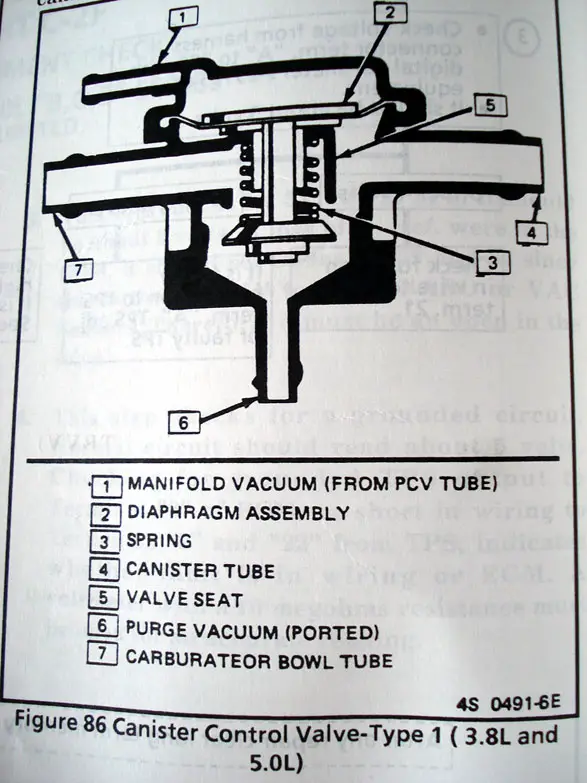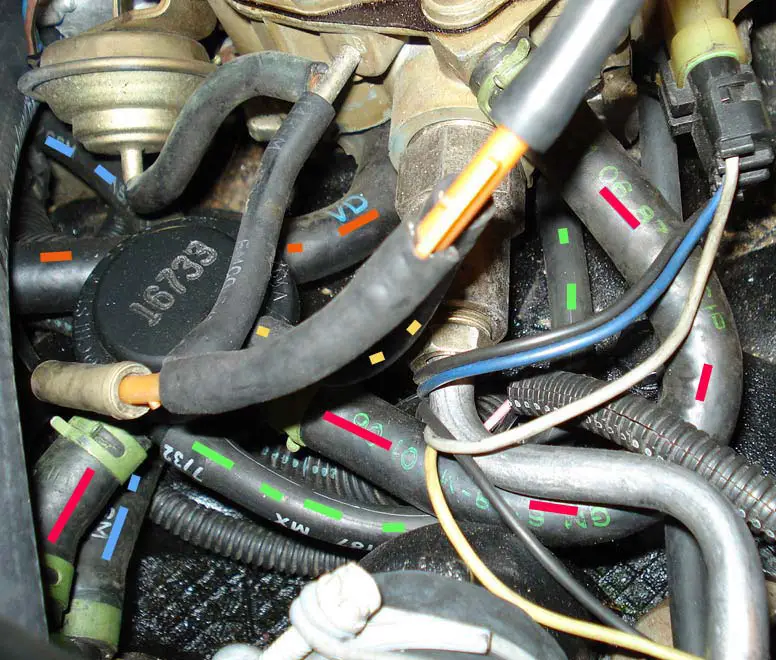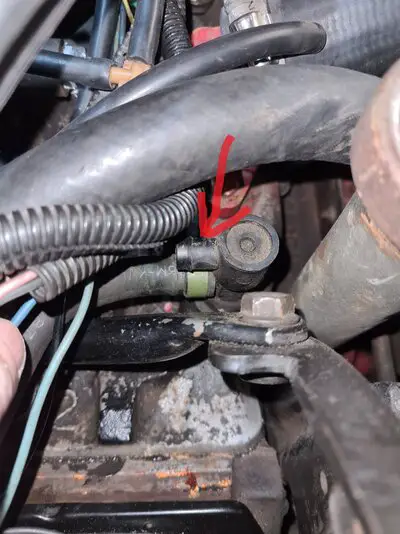I posted below in another thread about this and I'm too lazy to type all this crap out again, but this may help you understand a little of what you're working with.
In a nut shell, you can apply a vacuum signal to the TOP small port on the canister vent valve. That's what closes carb venting to the canister off when the engine is running. If you do that and you hear a vacuum leak or sucking sound, the diaphragm is shot and you'll need a new canister vent valve. That's about the only thing you can check on these things. Other than making sure there's no cracks in it otherwise. Another "problem area" is the TVS switch on the intake manifold itself. The spring is always pushing on the top cap and during old age, the cap can pop off and the spring shoots out somewhere, and then it's time for another TVS switch.
-------------------------------------------
The vacuum switch is simply a thermal vacuum switch (TVS), a temperature activated port switch to open and allow vacuum from the carb at 170 deg F or above to draw vapors from the canister. It uses a Canister Control Valve (CCV), a ported vacuum valve just behind the TVS. The TVS has a plastic cap glued on top which is holding a spring down to continuously try and keep the valve closed when the thermal portion expands and pushes up on it. Sometimes that cap cracks and pops off, leaving the valve to leak vacuum like a screen door on a submarine.
When it's off, the CCV loses vacuum and opens to vent the carburetor bowl (3/8" hose on the front of the carb top) to the carbon canister through the CCV if you're TVS is still open. When the TVS cools off, the spring closes the TVS valve in effect cutting off venting the carb to the canister.
The charcoal canister absorbs those vapors from the tank and the carb, and they're supposed to sit there until the engine runs to temp again, getting sucked into the engine. There is an upper and lower membrane inside the charcoal canister that keeps the chunkies in place. If the upper breaks, the engine will suck up some granules. You'll find it in the hose to the TVS, from TVS to CCV, inside the CCV, and into the carb vacuum port. You can take all those hoses off and blow them out, but the canister and maybe the CCV is essentially done at this point. You CAN rebuild the canister with new activated charcoal bits from say the fish tank stuff, but it's a process.
You can try this, although I've never done it- take the TVS off, heat up the pellet end in a pan of water until it gets hot. Then blow air through one of the ports (top port preferably to go backwards), and then check to see that it seats when it cools off. If it does, no need to replace it. Although you can usually find them new for <20 bucks. The CCV diaphragm gets old and cracks eventually then leaks. So I'd just replace that if you're going to be fixing it.
A new TVS is GM p/n 22536551, or ACDelco part number 212-122, or Standard Motor Products PVS-42
A new CCV p/n is GM/ACDelco 17085929, or Standard Motor Products CP108


In the picture above from an 87 442 307 VIN9, you get this-
The Blue dashed hose is coming from the charcoal canister to the TVS.
The Red dashed hose is going to the CCV (has 16733 stamped on top of it, #4), it also comes out of the bowl vent on top front of the carb (#7)and comes into the large port on the side of the CCV.
The Green dashed hose is coming from the CCV to the baseplate of the carb (#6). This is where the venting goes for the charcoal canister when the engine is running and TVS is open.
The Tan dashed line (#1) is coming from the air cleaner diverter valve "Y" to provide full time vacuum on the CCV to close the carb vent when the engine runs.
The Orange dashed line is your PCV line to the carb.
Hope that sheds a bit of light for you.
In a nut shell, you can apply a vacuum signal to the TOP small port on the canister vent valve. That's what closes carb venting to the canister off when the engine is running. If you do that and you hear a vacuum leak or sucking sound, the diaphragm is shot and you'll need a new canister vent valve. That's about the only thing you can check on these things. Other than making sure there's no cracks in it otherwise. Another "problem area" is the TVS switch on the intake manifold itself. The spring is always pushing on the top cap and during old age, the cap can pop off and the spring shoots out somewhere, and then it's time for another TVS switch.
-------------------------------------------
The vacuum switch is simply a thermal vacuum switch (TVS), a temperature activated port switch to open and allow vacuum from the carb at 170 deg F or above to draw vapors from the canister. It uses a Canister Control Valve (CCV), a ported vacuum valve just behind the TVS. The TVS has a plastic cap glued on top which is holding a spring down to continuously try and keep the valve closed when the thermal portion expands and pushes up on it. Sometimes that cap cracks and pops off, leaving the valve to leak vacuum like a screen door on a submarine.
When it's off, the CCV loses vacuum and opens to vent the carburetor bowl (3/8" hose on the front of the carb top) to the carbon canister through the CCV if you're TVS is still open. When the TVS cools off, the spring closes the TVS valve in effect cutting off venting the carb to the canister.
The charcoal canister absorbs those vapors from the tank and the carb, and they're supposed to sit there until the engine runs to temp again, getting sucked into the engine. There is an upper and lower membrane inside the charcoal canister that keeps the chunkies in place. If the upper breaks, the engine will suck up some granules. You'll find it in the hose to the TVS, from TVS to CCV, inside the CCV, and into the carb vacuum port. You can take all those hoses off and blow them out, but the canister and maybe the CCV is essentially done at this point. You CAN rebuild the canister with new activated charcoal bits from say the fish tank stuff, but it's a process.
You can try this, although I've never done it- take the TVS off, heat up the pellet end in a pan of water until it gets hot. Then blow air through one of the ports (top port preferably to go backwards), and then check to see that it seats when it cools off. If it does, no need to replace it. Although you can usually find them new for <20 bucks. The CCV diaphragm gets old and cracks eventually then leaks. So I'd just replace that if you're going to be fixing it.
A new TVS is GM p/n 22536551, or ACDelco part number 212-122, or Standard Motor Products PVS-42
A new CCV p/n is GM/ACDelco 17085929, or Standard Motor Products CP108


In the picture above from an 87 442 307 VIN9, you get this-
The Blue dashed hose is coming from the charcoal canister to the TVS.
The Red dashed hose is going to the CCV (has 16733 stamped on top of it, #4), it also comes out of the bowl vent on top front of the carb (#7)and comes into the large port on the side of the CCV.
The Green dashed hose is coming from the CCV to the baseplate of the carb (#6). This is where the venting goes for the charcoal canister when the engine is running and TVS is open.
The Tan dashed line (#1) is coming from the air cleaner diverter valve "Y" to provide full time vacuum on the CCV to close the carb vent when the engine runs.
The Orange dashed line is your PCV line to the carb.
Hope that sheds a bit of light for you.


